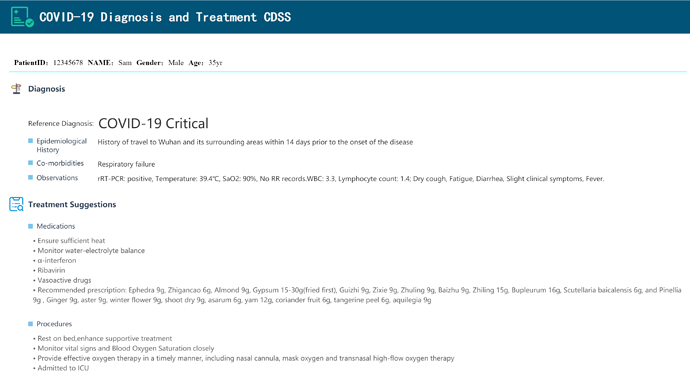Dear Colleagues,
On behalf of all the members of Xudong’s @lvxd team, I’m pleased to share our GDL rules and related archetypes regarding the Chinese COVID-19 Guideline. The files are now available on GitHub (https://github.com/ZJU-BME-VICO/openEHR-COVID-19). Everyone is encouraged to test, use, fork, and feedback on the rules and archetypes freely.
In China, COVID-19 broke out in December 2019 and has been under control for a couple of weeks. Of all the 81093 patients, 72703 are already fully recovered and reunion with their families. This achievement is significant, and the experiences leading to it are worth sharing with the world. Some researchers are already working on translating the Chinese guidelines to English and Persian (probably other languages as well) to facilitate the sharing among care-givers. We, as informaticists, believe taking advantage of the open standard (i.e., openEHR) and a formal guideline language (GDL2 in this case) would not only accelerate the sharing process globally but also reduce the ambiguity in the narrative texts.
Since our primary goal is supporting the diagnosis and treatment, the archetypes and GDL rules are adopted from the diagnosis and treatment part of the Chinese guideline. The data elements and rules in the rest parts of the guideline are out of our scope. The GDL rules are authored and validated by the GDL2 Editor. Detailed instructions are available in GitHub.
To demonstrate how the rules can be used in clinical decision support applications, we are developing a demo. Since we didn’t manage to find a dedicated open-source GDL2 execution engine, we choose a quick and dirty solution - translating GDL2 to Drools and using the Drools rule engine. The related Java data model and the Drools rules are also available in our GitHub project. To talk about the positive side, we hope this additional work will attract those non-hard-core openEHR users to use our GDL rules.
At this moment, we are working on adapting the archetypes and rules to the latest edition of the Chinese guideline (i.e., 7th edition). In the meantime, we are also improving the demo application by adding a data entry user interface automatically generated from the openEHR template.
Heather @heather.leslie has been helping us with modeling for a couple of weeks. While we sincerely thank her for her time and efforts, we are now calling broader help (esp. from clinicians, experienced modelers, and GDL experts) to review, test, and comment on our archetypes and rules.
May our joint efforts accelerate the winning of the global battle against the virus.
